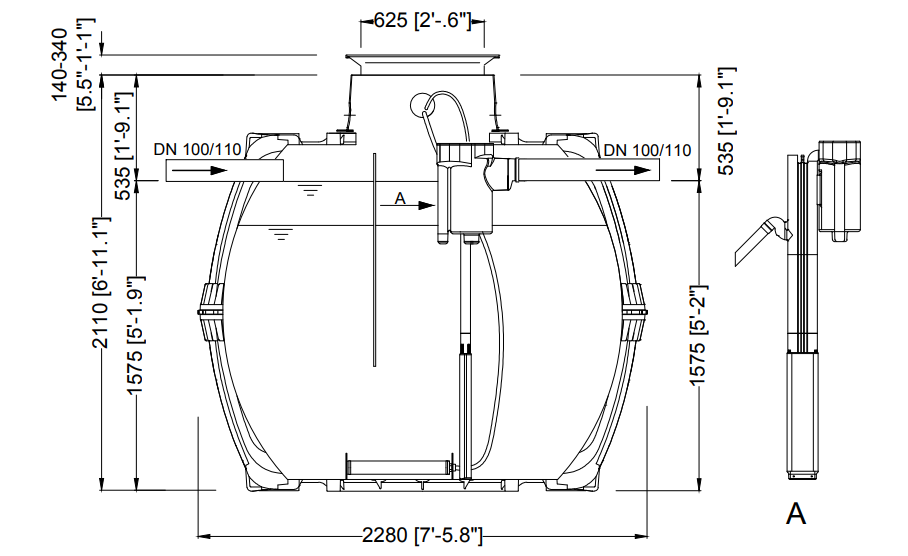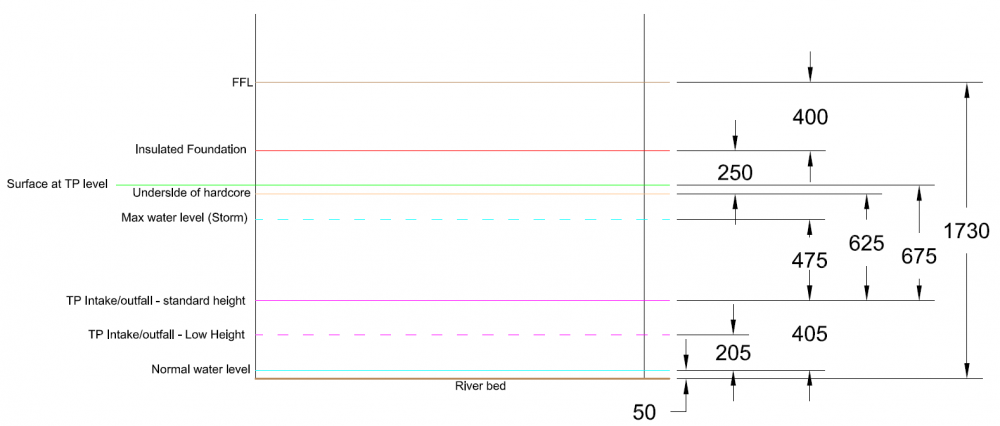Search the Community
Showing results for tags 'treatment plant'.
-
Having spent 2 weeks in the trenches installing the drains, I am at your service for the differences between theory and practice. After 40 years of designing drainage, but never afraid to get down there, I learnt a few things. Also about Chemfloor.
- 24 replies
-
- 2
-

-

-
Wednesday 26th June, I spent most of this day travelling, in my van and my two helpers for the next few weeks. The trip is 433 miles door to door, the goal before the boss arrives for 9 days was to get the caravan (home) connected to the treatment plant. plus get ready for concrete. other blogs to follow. To connect the Static I needed to install the treatment plant, install some of the drainage for the pods, confirm with BC he is happy and basically crack on with the long days that far north. Previous work had the pit dug out of the rock, so the basic plan was to sit the plant onto compacted, level, stone and backfill with gravel. Then put a top of concrete to hold the whole thing down. In the 8 weeks the pit was open there was no filling of the pit, so I was quite happy the rock was porous, but couldn't be convinced in heavy rain it wouldn't fill with water. The rock at the bottom wasn't going anywhere, so didn't see the point of fully filling with concrete. I backfilled with stone up to around 350mm from the central rib of the TANK (a Tricel Nova 12P) then put 3 cube of concrete over this. this concrete is now bonded to the rock sides to the pit and if my tank floats its going to have to bring the bed rock with it. The observant of you will note it sits a little higher than the ground. This was for two reasons. - to assist with the outflow depth for the rubble drain, and secondly I am going to raise the level of the ground in this and the rubble drain area, to soften the impact of the house, that will sit further East on slightly elevated ground. (I also buried a 5 ft earth rod in the concrete for the future) I got my levels from the pods to the tank a distance of approx. 46.5M, and worked out my fall, the levels of the land assisted this, i..e the pods to the West and the House to the East of the treatment plant are both elevated, with the treatment plant in the lower part, and near the existing rubble field drain. (our initial survey and plans worked. Phew) The trench for the waste pipe was also used for services (Water, telecoms, electricity, Ethernet) , backfilled with stone and fill from site. I then laid the pipe, with a fall, and supported this on flat rocks. Connecting lengths of pipe together on your own is not easy, (I asked the dogs to help, but the lack of thumbs became an issue. ) Top tip, long ratchet straps make this an easy process. the picture below shows this, I broke the length of the run up with branches for rodding points, not required at these distances, but makes sense and easier rodding if required. The ratchet strap is 15 m long, at one point I had two connected together. simply loop the hook around the chamber, or branch and the other end around the pipe you are connecting and a few ratchets later the pipe slides into place. Once all in place and re checking the levels I used stone (lots of stone) to fill the voids under the pipe, re-checking the levels (falls) and compacting as I went. I tested this run of drainage with bungs and water manometer. Building control were happy not to inspect before backfill, as long as I was happy that if it failed the pressure test later that was my issue... My initial meeting with building control, laid the ground for our relationship, I asked what he wanted, showed him my proposals, chatted about this and that and hopefully from this he could see I wasn't a muppet, so we agreed to move forward with a few photo's here and there and he might pop in at anytime if he was passing. works for me. One of the branches that will be a rodding point is doubling up as my caravan connection. For now the Treatment plant is running by being plugged in. I Will run the SWA cable but this will be powered from a house yet to be built, so for now, comes from a Caravan hook up point, with RCBO protection. Part two will be the rubble drain this is still work in progress..
-
- 2
-

-
- occumster.
- highlands
-
(and 2 more)
Tagged with:
-
I know this is probably done to death, but a lot of the posts I came across were older. I’m planning the drains for our new build (4 bed), did a percolation test at the weekend and took 7 hrs to drain away, so looking at treatment plants. Kind of narrowed it down to Bio-Pure, WPL, Conder but I do keep coming back to Biorock for several reasons. Any up to date opinions on the above? I do like the fact the Bio rock is electric free, I’m more than capable and happy to install and if I can commission, service it myself down the line even better. Also how are people finding the desludging intervals? On our own farmland so no issues with siting, probably going to be approx 35m from the house.
-
I'm rapidly approaching starting work on site. Civils mate who is doing groundworks called yesterday to say he could start next week if I wanted, but I haven;'t yet engineered the life out my drainage and levels and hence I am not quite prepared. I've a large flat plot, and using Treatment plant and a direct discharge into a burn (SEPA approved). I'd deliberately set the house 'into the' ground rather than on it, so that it looked natural rather than sitting on top of the ground, and also to avoid excessive extra infill material if I raised it up. However this leavesme limited amount if space from FFL to the normal water level in the burn, approx 1.25m. I am following the popular Kore foundation system route and expecting that I need to drop all drainage out through the bottom, rather than put sewage pipes out walls. The issue I have is that I am struggling to get the fall required and also protect against backflow from the burn. Normally the burn is only 50mm deep, but when there is heavy rainfall and storms it can rise 1m. The distance from the drainage through the slab to the TP is 45m, and this is where i am struggling to achieve the minimum 80:1 fall on the sewage outlet. See diagram below, some buildup notes Depth of Kore system - approx 400mm Hadcore and sand blinding: 250mm From here, I have guessed that I can leave the drainage pipe 50mm below the underside of the hardcore. Now using a GRAF one 2clean (It'll be that or equivalent, biopure, etc). From where the septic tank is to be sited, I drop it 675 below surface (535 + 140), I f i assume that the drainage pipe top is 50mm clear below the bottom of hardcore, and it's a 110mm pipe. Then that means the fall height is 465mm (625-160) which is over 45m giving a ratio of 96:1, which is a good shallower than it needs to be. Second issue being, even with the TP being as high as possible here, during storms I will backflow the tank. I think this can easily be dealt with using a backflow device (picture below) the water usually comes down within a few hours - however I suppose it could stay up for a day if we had a prolonged period of rain (I'm on the west coast of Scotland - so highly likely). Now possible solution is to drop the tank down further 200mm - which would give a much more reasonable (465+200= 665 fall height) 67:1 over the 45m. However now I'm very close to the water level (205mm) constantly and regularly it would come up above the outfall. I was trying to make sense of the best route here by asking - but in writing this thread I think I have answered my own question. It would seem that the best plan is to drop the Tank down the extra 200mm and then just changed it from a gravity type to a pumped solution, then this all goes away? or do I do somethign different and pop the waster out the wall - which won't seem to be an elegant solution? In either case I'll need a backflow device, regardless for peace of mind. I've attached the site plan and foundation plan for reference. Apologies it might be a little disjointed and hard to follow...I've been rattling this around in my dreams all last night and needed to put it on paper to work it through. 724-11 Site Plan.pdf 724-13 Foundation Plan.pdf
- 7 replies
-
- invert
- insulated raft
-
(and 1 more)
Tagged with:
-
My iwox treatment plant comes with a remote alarm light for the sir compressor. They recommend to install a 5 core 2.5mm swa to accommodate this. We only buried a 3 core some months back. What could I use that I will have any chance of getting through the gland on the tank as well as the 3 core swa? Thanks in advance
- 9 replies
-
- alarm
- treatment plant
-
(and 1 more)
Tagged with:
-
I've started designing a remote alarm/air pump pressure system, prompted by this series of posts quoted from the closed Ebuild forum: Following on from the above, I decided it would be nice to have our alarm relocated with an indoor display, that would not only provide the "low pressure" and "high level" alarms at a convenient location, but with the addition of an indoor pressure display, to give early warning of sediment build up, so avoiding (hopefully) the problem that Peter reported. I have the pressure sensors, have tested them and the interface to a wireless data link that will comfortably work for 50 to 60m through walls. I have three choices. I can make the outdoor unit larger and fit a battery a solar panel, and have the indoor unit as a hand-held battery powered unit that could interrogate the external unit on request. The power demands make this arrangement impractical for giving a real-time alarm, it would rely on being interrogated to find out whether things were still OK, its major shortcoming. The next option is to have a solar powered external unit transmitting to a mains powered internal unit. This would provide continuous monitoring and alarm, at the cost of a solar powered external unit that would be relatively large (because of the battery and solar panel size) an would cost more, plus the battery would need replacement every few years. The final option is to have a mains powered unit inside and outside the house. This would probably be the best solution if there is mains power available at the treatment plant, as it would be the most reliable. In terms of power, it would use less than 1W at each end. This post is really to see if anyone is interested, as I'm making one for our build, and it's very little trouble to make one or two extra. I'm probably going to opt for mains powered at both ends, as that suits us better, but there really isn't much to choose in terms of hassle to make other types. Anyone interested?
- 38 replies
-
- 1
-

-
- treatment plant
- alarm
-
(and 3 more)
Tagged with:
-
Hi All, I have read a lot of the older posts on BH regarding these, and wondered if anyone had any recommendations. I had planned to put my new build onto Mains sewer, and for those that have read my other posts ..the plan was to channel through parents land to get to the closest access....moving them from an old brick cesspit too Sadly, the lateral that should have been there ..isn't and after spending a few hundred and digging up loads of their garden it appears "anecdotal" tales of the mythical ...spur to all properties ..is just that ...a distant race memory from the 1970's What led us to believe that there MAY be a lateral or spur there is the neighbours connected several years ago ...but this is where a can of worms well and TRULY opened ...apparently that connection is not "legal" according to the water board and no work or application was filed and that i cannot connect to that anyway as it breached this rule and that and the other ...they will now be contacting the homeowner as they have never received a penny in sewer charges .....OOOPS! ..Well how was I to know? (sigh) So now the alternative is for us to "core drill" at 2.7m deep at Main sewer which is about 20m away across a path, green verge and yes ...a road. I have had a few quotes and to be honest ...After everything is done ...I doubt i will have much change left from £15k-£17k ...Which is a killer for us. So I am back to thinking about an alternative ....We have a decent back garden (or will have) and i suppose the front is possible also .. We do KNOW about the older brick cesspits ....and to be honest ..we were not impressed ...emptying at least twice a year and then having to rod it several times also and being stood up to the knees in well ...PIT & SHISS ....Not i deal ..well of course this pit is 40 years old ... I am hoping there is a modern equivalent that doesnt smell in summer and that needs minimal maintenance ...OH, and keep the council happy. Easy?
- 25 replies
-
Whilst doing so groundworks the other day, I had to remove a riser from our treatment plant inspection chamber. I took the opportunity to take a quick sample of the treated effluent to see how clear it was and if there was any detectable odour. I'm pleased to say it was both clear and odour free. The treatment plant itself (Biopure) appears to be working as it should, the air pump diffusing air into the central digestion chamber, with the outer chamber topped by a layer of scum which I believe will eventually form into a crust. I'd like to be able to test the quality of the treated effluent, to see how clean said effluent is (and whether the results match the manufacturers stated performance) but I can't seem to find any kits to do this, other than by spending a fair chunk of cash: http://www.camlab.co.uk/palintest-sewage-effluent-kit-p26092.aspx Just wondering if anyone else has self tested their treatment plant effluent and what did they use?
- 1 reply
-
- effluent testing
- sewage
-
(and 2 more)
Tagged with:
-
hi all, just wondering if anyone has used a viltra treatment plant simon
-
Reading the recent thread about treatment palnts has made me wonder if we are overcomplicating things. We have all sweated blood to reduce our heating bills by perhaps £1000 per year, and cut the concomitant environental impact. Good. But spending £400 or £600 a year to run a treatment plant seems to me to be a backward step, as it is as much as, or more than, mains connection (South West excepted!). As a household we are now on mains drainage, but at our old house we spent 15 years on a septic tank, which was then replaced for 15 years by an Aquatron (ie a whole house soil closet with an inert centrifugal separator - a plastic spiral with a hole in the middle - for Number 1s and Number 2s) . The Aquatron requirement was an initial install, no power, and a visit once a year with a wheelbarrow and shovel to get the compost. From the business end it felt just like the septic tank or mains connection. Is there another race-to-technological-gimmicks going on here - like the ones we have seen in Grand Designs where Sophie and Sebastian use the enviro-savings to install an enviro-cost which is not actually necessary. Just musing. Ferdinand
- 26 replies
-
- sewage treatment
- cost of sewage treatment
-
(and 1 more)
Tagged with:
-
Hi, I'm Jeremy, just finishing a passive house build on the West Wiltshire/Dorset border. I'll have our build blog up on this forum shortly.
- 6 replies
-
- passive house
- wiltshire
-
(and 6 more)
Tagged with:








.thumb.jpg.bac90f3bbf6868cf2118d010d936c99d.jpg)
